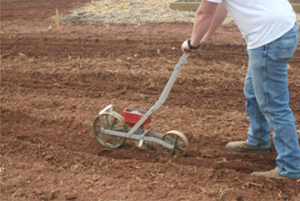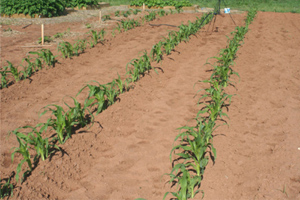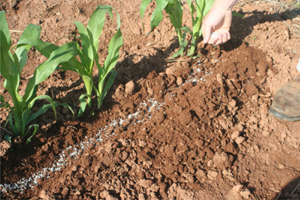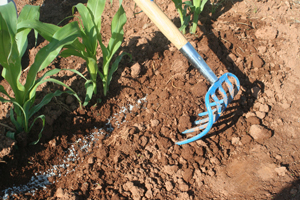- Types
- Soil Preparation
- Planting
- Fertilizing
- Watering
- Maintaining
- Maturity and Harvest
- Problems
- Recommended Varieties for the Georgia Gardener
Nothing can compare to the fresh, sweet, crisp taste of homegrown sweet corn that is picked and eaten on the same day. Sweet corn is certainly a favorite crop among home gardeners and, with the many varieties now available, there is one to suit every taste and need. Sweet corn is not difficult to grow and, by following the cultural guidelines provided in this publication, you too can enjoy this sweet delicacy.
Types of Sweet Corn
Sweet corn may be divided into three distinct types according to genetic background: normal sugary (su), sugary enhanced (se) and supersweet (sh2). There are also varieties now containing a combination of either two or all three of these genes, exhibiting qualities of each. These are sometimes designated as synergistic (sy) or augmented supersweet (shA.)
Standard sweet corn varieties contain a “sugary (su) gene” that is responsible for the sweetness and creamy texture of the kernels. Su’s are best suited to being picked, husked and eaten within a very short time. The sugar in Su varieties converts to starch rapidly, allowing them to be stored for only a few days.
Sugary enhanced hybrids contain the sugary enhancer (se) gene that significantly raises the sugar content above standard varieties while retaining the tenderness and creamy texture of standard varieties. No isolation from standard varieties is necessary.
Supersweet hybrids contain the shrunken (sh2) gene, which delays the conversion of sugar to starch, allowing them to stay sweet longer than su varieties. The kernels of the supersweet varieties have a crispy, tough-skinned texture and contain low amounts of the water-soluble polysaccharides that impart the creamy texture and “corn” flavor to other sweet corn varieties. Although the lack of creamy texture is not especially noticeable in fresh corn on the cob, it affects the quality of frozen and canned corn, as does the toughness of the seed coat. Unless corn must be stored, shipped or mechanically harvested, se’s are superior in eating quality to sh2’s.
Supersweets (sh2) should be isolated from any other type of corn tasseling at the same time to ensure sweetness and tenderness. Their pollen is weak and easily supplanted by other types, which causes the kernel to revert to a form with the toughness and starchiness of field corn. Because corn is wind-pollinated, this isolation distance should be 500 feet or more, especially down-wind.
Many new varieties contain two or all three types of genes. These may be called by several different terms including mixed gene, multi-gene, synergistic, sweet breeds, and extra tender, among other names. All of these should be isolated in the same manner as the sh2 varieties.
Soil Preparation
Sweet corn thrives best in loamy, well-drained soils but will tolerate a wide range of soil types. Optimum pH ranges from 6.0 to 6.5.
Till the soil to a depth of 6 to 8 inches using a spade, plow or rototiller. Avoid tilling the soil while it is too wet or large clods may be formed.
Planting
Sweet corn is a warm-season vegetable requiring soil temperatures between 60-90 degrees F. Avoid planting seed in cool soils. Wait until at least two weeks after the last average killing frost before planting. If planted too early, weak stands, stunted growth or frost-killed seedlings may result. The newer, sweeter varieties are even more sensitive to cool, wet soils and may not perform well in these conditions.
Plant corn in an area that receives at least 8 to 10 hours of sunlight. It is beneficial to plant near a water source for needed irrigation.
Plant seed approximately 1 inch deep in rows 3 feet apart with 8 to 12 inches between each seed in the row. A hand pushed mechanical planter can make seeding much easier for larger stands of corn (Figure 1).
Corn is wind pollinated, so plant four or more short rows of sweet corn side-by-side instead of one long row. This will aid in good pollination and ear development (Figure 2).
 Figure 1. Hand pushed mechanical planter.
Figure 1. Hand pushed mechanical planter. Figure 2. Plant several short rows.
Figure 2. Plant several short rows.
Plant sh2 and multi-gene varieties 400 yards away from standard varieties, or plant so maturity dates are 1 month apart to avoid cross pollination.
Fertilizing
A soil test through the local county extension office is always the best way to determine the lime and fertilizer needs. If lime is required, it can be tilled into the ground during soil preparation but is most effective when applied 2 to 3 months prior to planting.
If a soil test is not done, a general guideline is to apply 6 pounds of 10-10-10 per 100 linear row feet before planting. Fertilizer can also be broadcast at a rate of 30 pounds per 1,000 square feet. Sidedress two to three times during the growing season with ammonium nitrate (34-0-0) at a rate of 3 to 5 pounds per 100 feet of row. More frequent sidedressing may be required on sandy soils or when excessive rain occurs. Sidedressing involves digging a shallow trench on one side of the row, near the plant, and applying fertilizer. It is then covered with soil (Figures 3 and 4).
 Figure 3. To sidedress, dig a shallow trench along the row and apply fertilizer.
Figure 3. To sidedress, dig a shallow trench along the row and apply fertilizer. Figure 4. Cover the trench with soil to complete sidedressing.
Figure 4. Cover the trench with soil to complete sidedressing.
Watering
Water is vital to ensure a good stand of corn. Corn requires a minimum of 1 inch of water per week for normal development. The most critical periods for water are during pollination and during final ear filling.
Water sufficiently to moisten the soil to a depth of 6 inches. Irrigate in the early morning or early evening to allow foliage to dry before dark. Soaker hoses or drip irrigation placed alongside rows are an excellent way to irrigate corn and conserve water.
Maintaining
Keep rows clean and free from weeds. Light, shallow tilling between rows can be done, but take care not to get too close to the root system of the corn. After cultivating with a tiller or hoe, mound soil 2-3 inches up around the base of the plants to support stalks from wind damage. On small stands of corn, where it is practical, place organic mulches around plants to help conserve moisture and control weeds. Chemical herbicides are also available to aid in weed control.
Maturity and Harvest
Sweet corn matures in 60 to 100 days, depending on the variety. For a continuous harvest, plant early, mid and late season varieties or make successive two-week plantings of the same variety.
Sweet corn should be ready for harvest about 20 days after the appearance of the first silk strands. Sweet corn is picked during the “milk stage,” when the kernels are fully formed but not completely mature. Sweet corn is ready to harvest when the silks become dry and brown and the kernels are smooth, plump and pop open when punctured with a thumbnail. Not every ear in the row will be ready at the same time and they may mature several days apart.
After picking, cook and eat corn right away or store it in cool temperatures, such as in a refrigerator, as soon as possible. It can then be canned, frozen or eaten fresh within a few days. Keeping the corn cool is the key to better flavor as high temperatures will convert the sugar in the kernels to starch, giving it a bland taste. Although many new varieties have extended storage quality, most lose 50 percent of their flavor within 12 to 18 hours of picking if left unrefrigerated.
Problems
Common cultural problems of sweet corn include poor kernel development caused by dry weather during silking, planting too close, poor fertility, too few rows in a block causing poor pollination, and lodging (falling over) from too much nitrogen and/or wind damage.
High temperature and poor water management during the tasseling stage can cause poor pollination and fewer kernels on the ears. Insects such as Japanese beetles can also affect kernel pollination by eating the silk.
Common insect problems that will be encountered in sweet corn include corn earworm, aphids and flea beetles. Cutworms, seed-corn maggots, Southern corn rootworm, wireworms, fall armyworm, European corn borers and Japanese beetles may be encountered as pests of sweet corn.
Check with your local county extension agent for recommendations for controlling and preventing these pests.
Sweet corn is seldom seriously damaged by diseases in the home garden. The following proper cultural practices can reduce or prevent many potential disease problems:
- Obtain seed from a reputable seed source and use fungicide, pre-treated seed to reduce problems with damping-off.
- Plant when the soil temperature is above 55 degrees F to reduce most seedling rots.
- Keep the garden free of nearby weeds, which can harbor viruses.
- Remove corn smut-infested ears promptly from the stalks and garden area.
- Remove plant debris after harvest to reduce diseases that may over-winter in the old stalks.
Recommended Varieties for the Georgia Gardener
| Variety | Days to Maturity | Gene Type |
| Yellow | ||
| Bodacious | 75 | se |
| Honey Select | 79 | Triple Sweet Hybrid |
| Mirai 131 | 69 | Triple Sweet Hybrid |
| Seneca | 64 | su |
| Golden Queen | 92 | su |
| White | ||
| Silver Queen | 92 | su |
| Silver King | 80 | se |
| How Sweet It Is | 87 | sh2 |
| Avalon | 82 | Triple Sweet |
| Seneca Sensation | 70 | se |
| Silver Princess | 74 | se |
| Nicole | 72 | shA |
| Bi-Color | ||
| Butter & Sugar | 75 | su |
| Ambrosia | 75 | se |
| Serendipity | 82 | Triple Sweet Hybrid |
| Honey ’n Pearl | 76 | se |
| Sweet Breed Chorus | 67 | Multi Gene Variety |
| Mirai 301 | 76 | Triple Sweet |
| Peaches & Cream | 83 | se |
| Montauk | 79 | sy |
| Rosie | 74 | shA |
| Providence | 82 | Triple Sweet |
Status and Revision History
Published on Dec 15, 2006
Published on Oct 13, 2009
Historic/Archived on Dec 01, 2012
Published on Oct 15, 2019
Published with Minor Revisions on Oct 17, 2019
Published with Full Review on Sep 03, 2024
